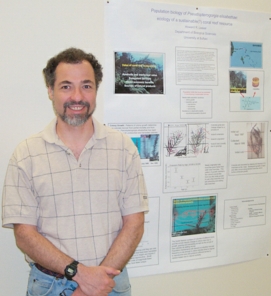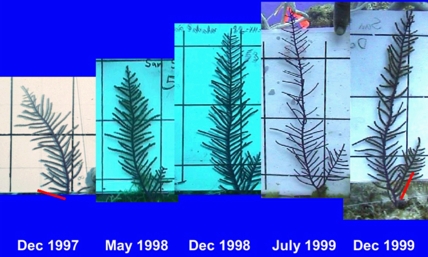 |
Howard R. LaskerEvolutionary Biology and Ecology; Population Ecology of Marine Invertebrates Professor Ph.D 1978 University of Chicago |
 |
Howard R. LaskerEvolutionary Biology and Ecology; Population Ecology of Marine Invertebrates Professor Ph.D 1978 University of Chicago |
Howard R. Lasker
Department of Biological Sciences
443 Hochstetter Hall
State University of New York at Buffalo
Buffalo, NY 14260
(716) 645-2363 ext: 184
To send e-mail: hlasker@buffalo.edu
For our Lab Web Page please click here
Population ecology of
Pseudopterogorgia elisabethae. - Pseudopterogorgia
elisabethae is a common gorgonian of coral reefs throughout
the Caribbean. Colonies are harvested for a pseudopterosin, a
natural product that has anti-inflammatory properties and which
is used as a topical agent in cosmetics. We are studying and
modeling the population ecology of P. elisabethae
focusing on those parameters crucial to the development of a
management plan. The project encompasses studies of the species
recruitment, growth and survivorship. We are also studying P.
elisabethae population genetics as well as developing
methods for colony propagation that can be used in mariculture. A
larger and more general goal of the project is to identify the
parameters that must be incorporated in analyses of coral
populations and determine whether there are ''ecologic profiles''
that can be used to differentiate species that should be highly
protected from those for which managed harvesting is ecologically
sound.
Evolution and development of colony form among gorgonian
corals. Form affects the manner in which benthic taxa
extract resources from the environment, resist physical
disturbance and interact with competitors and predators.
Understanding how form develops and varies within individuals
over their life spans, between individuals across habitats and
among species is a crucial component to understanding sessile
taxa and their interactions with their environment and other
biota. Using gorgonian corals as a model system I am conducting a
multi-level analysis of colony form. The research focuses on
models that address the question, “How are colonies
organized?” Descriptive models along with a series of
manipulative experiments are being used to determine which
features of branches best characterize their future growth and
branching behavior.
Gorgonians like most colonial taxa have highly plastic colony
forms. Is that plasticity produced by the local environment
interacting with assembly rules that are themselves invariant or
do assembly rules change as a function of the local environment
and the colony's history? These questions are being investigated
using observational data and manipulative experiments.
Fertilization success among broadcast spawning benthic
invertebrates. - Analyses of marine invertebrate life
history strategies have generally ignored fertilization rates as
a factor in the organism's life history, and most studies have
implicitly assumed high fertilization rates. Our data (Lasker et
al. 1996) on Caribbean gorgonians are among the few data on in
situ fertilization rates for a broadcast spawning species.
Fertilization rates of eggs vary from 0 to near 100% on different
nights and different spawning events. The variance between sites
and times is enormous, but much of the time many eggs go
unfertilized. This result has now been verified in four different
species in reefs in both Panama and the Florida Keys. The
presence of sperm limitation among broadcast spawning species
suggests a variety of reproductive strategies that may be pursued
by colonies and also suggests dichotomies between male and female
colonies. We are examining fertilization strategies among
gorgonians using a combination of fertilization success models,
data ib in situ fertilization and genetically determined
paternity of larvae produced in natural spawning events.

Photographs of a Pseudopterogorgia elisabethae colony from San Salvador, Bahamas. The replicate photos are used to measure growth rates and determine the resilience of the species to harvesting.